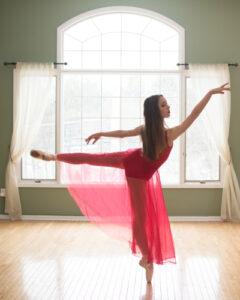 In addition to identifying four formal elements of line in dance tradition, Laban also noted two contrasting forms – the arabesque and the attitude. While these have become stylized motions in ballet, Laban perceives the arabesque more generally as any direct, scattering shape and the attitude as any flexible, gathering motion.
In addition to identifying four formal elements of line in dance tradition, Laban also noted two contrasting forms – the arabesque and the attitude. While these have become stylized motions in ballet, Laban perceives the arabesque more generally as any direct, scattering shape and the attitude as any flexible, gathering motion.
Both forms reveal something about the mover’s relationship to the surrounding environment. According to Laban, both represent “fundamental urges.” The direct scattering or pushing away motion of the arabesque expresses repulsion, while the flexible gathering action of the attitude is a gesture of possession.
Is Laban right? Do gathering and scattering shapes represent fundamental urges? Find out more in “Mostly about Shape,” starting in April.
